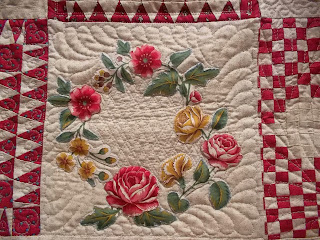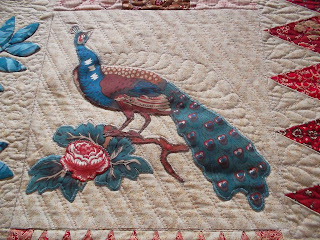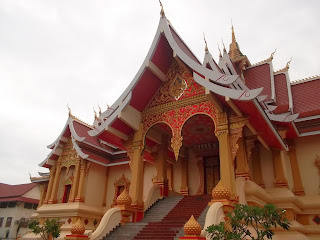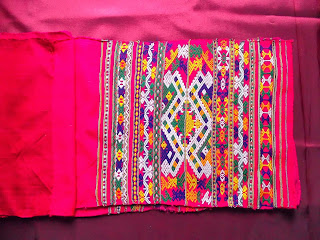My DH and I visited Laos for a few days earlier this month. My DH was born in Laos and spent several years there living mostly in Vientiane. It was my first visit to Laos.
I will divide my photos between several posts.
We stayed in Vientiane, the administrative capital of Laos.
One of my first impressions was seeing many women and children still wearing the traditional sinh (Laotian skirt) in their everyday life. The school girls' uniforms all have a sinh as their skirt. Many office and shop uniforms include a sinh and many ladies just walking down the street still wear a sinh.
In
this post (scroll down a little) you can see my DD in her wedding sinh.
On the 2nd day I found a shop selling antique textiles.
This piece is about 50 or 60 years old and would have been made by a young girl, maybe 17 or 18 years old. When a young girl is interested in a young man she gives him a "love gift handkerchief" (Pha Khan Mon) . Not only are the girl's skills as a weaver and embroiderer displayed, but the piece is a "window to her soul". If the young man's family liked the girl's work, then their marriage would be organised.
The symbols also have meanings.
Below in green is a frog.
These designs could be butterflies.
This could be an elephant. Elephants have been important in Lao history. It could also be interpreted as a dragon or lion. This symbol protests against natural disaters or accidents.
I purchased a 2nd textile which was used as a money belt. It is about 40 years old.
This is a long scarf like textile which was wound around the waist. The decorated ends were folded to carry money. I was told the longer the piece the more money you have! This one is so long there is a join! (see above)
The large, white diamond symbol woven in both ends is said to offer protection and ward off negative energy.
I also purchase some modern sinh fabric. I think all of these were made on a machine (rather than being woven by hand on a loom at home), but the designs in the fabric are beautiful!
Above is a "tin sinh", or border hem piece, temporarily stitched to the main sinh fabric. This is traditionally how the sinh and its decorative hem are purchased. When the sinh is made the border is restitched to the hem of the skirt.
Nowadays there are many sinhs with the border woven as a single piece of fabric.
The diamond symbol appears in all of these designs.
While we were in Laos I could only gather a small amount of information because I don't speak Lao and many people don't speak English. My DH interpreted some information for me, but its difficult to remember everything! I am fascinated by the dying and weaving processes, the uses of the textiles and the meanings of the symbols woven in each piece.
I would love to go back and learn more! In the mean time there has been lots of Googling!
In following posts I will have lots of photos of wats (pagodas) and photos and a little about the festival we attended.....as well as some applique and quilting!








































